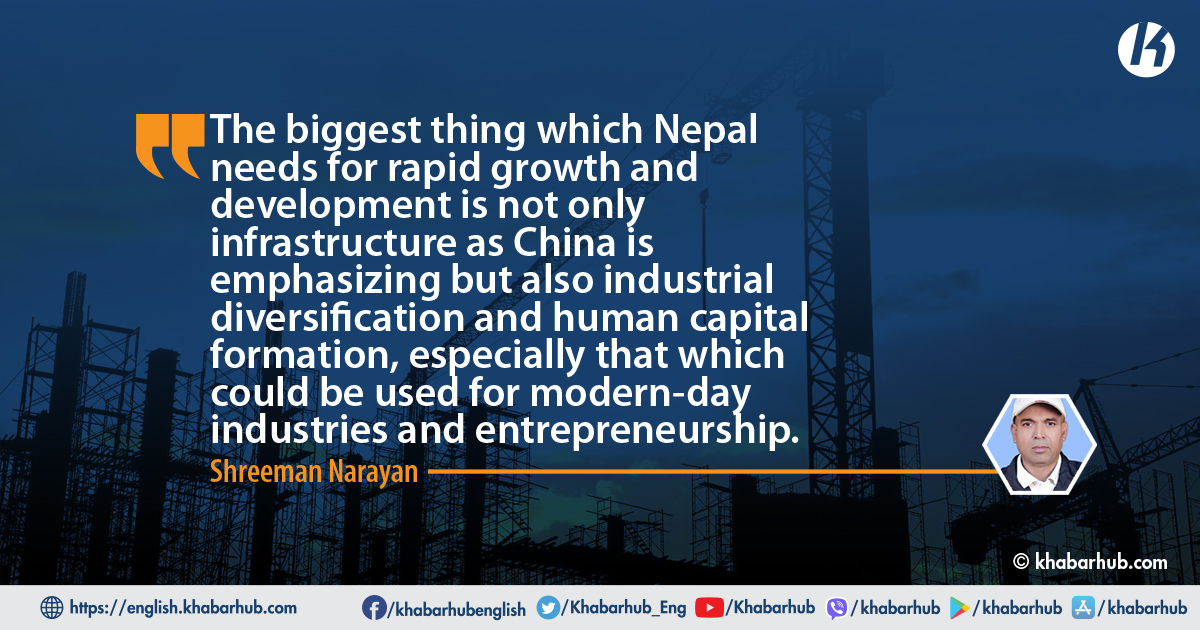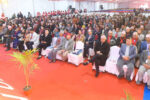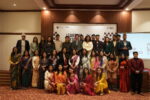Belt and Road Initiative (BRI), previously called One Belt One Road (OBOR), which initially raised lots of hope that it could be instrumental in Nepal’s graduation from LDC is now waning because of its failure to take off as conceived.
It is because of confusion and lack of clarity, and commitment on the part of China.
The degree of confusion could be ascertained from the recent denial of Nepal’s Foreign Minister N.P. Saud that the newly built Pokhara Airport was one of the projects under the BRI as claimed by Chinese Ambassador Chen Song to Nepal.
The Nepalese Minister also claimed that Nepal has signed the pact but no tangible plans of initiatives have been implemented as yet.
Earlier at the time of the inauguration of the project, Nepal Prime Minister Pushpa Kamal Dahal had claimed that the project was under the BRI.
Realizing that in its efforts of LDC graduation, Nepal would need to build capacity and remove various bottlenecks and impediments in the growth and diversification of the economy along with developing human capital, China offered its lucrative OBOR as an opportunity for the same.
Nepal’s China engagement is not on equal negotiation footing. Sundernath Battarai, the Executive Chairman of the China Study Centre, a Kathmandu-based think-tank said part of the confusion in Nepal about BRI projects is Nepal’s lack of negotiation skills, and its unwillingness to negotiate with China.
As Nepal’s government is predominantly dependent on tourism and hydropower for revenue, it lacks the requisite capital and expertise to build infrastructure and develop its human resources.
This handicap of Nepal led them to think that BRI is an opportunity.
China-led BRI was embraced by Nepal in 2017, an opportunity to build vital infrastructure.
BRI is a global infrastructure development strategy that was started in 2013 to invest in more than 150 countries and international organizations.
Today, it is also considered a centerpiece of Chinese President Xi Jinping’s foreign policy as well.
BRI aims at building railroad, roads, bridges, airports, dams, coal-fired power stations and other vital infrastructure for realizing a connectivity vision through overland routes viz.
The “Silk Road Economic Belt” and Indo-Pacific Sea routes viz. “21st Century Maritime Silk Road.”
But today, as it stands OBOR has failed to create the desired impact and landed some of them into the debt trap. It is a matter of worry for Nepal as well.
In 2017, Chinese Ambassador to Nepal Yu Hong and Nepal’s Foreign Secretary of Nepal Shankar Bairagi signed MoU to join the BRI that year in China.
While signing the agreement, the Nepali officials expected that “the agreement will bring Nepal and China closer through road connectivity and bring home the Chinese investment.”
It was also expected that the deal would help Nepal in attaining economic prosperity by promoting trade and investment.
Yu expressed hope that the project would contribute to enhancement of China-Nepal cooperation as well as economic development of the South Asia region itself.
According to Nepal Foreign Ministry statement “the MoU aims to forge cooperation on promoting connectivity of facilities, trade connectivity and financial integration.
Now, after five years of the signing of the MoU, Nepal’s enthusiasm and great hopes regarding the BRI’s instrumentality in its LDC graduation is waning.
The reasons are not far to see.
First, notwithstanding the proposal of Nepal to consider 35 projects under the BRI framework, to begin with only nine were formalized.
Another set of nine agreements were agreed upon during Wang Yi’s visit to Nepal in March 2022.
From the very beginning, China appears to have been trying to pool and display all its ongoing projects in Nepal under the BRI umbrella.
Khadka KC, Professor at the Department of International Relations and Diplomacy of Tribhuwan University said the Chinese side might have been listing the projects to show increasing engagement between Nepal and China.
“They might have wanted to increase their engagement and visibility in Nepal, which they believe, is pale in comparison to India.”
In fact China has listed many of the ongoing projects in Nepal under the BRI said Nepal’s Foreign Minister N.P. Saud.
He added, “Not a single project in Nepal under the BRI has been executed.” Even if inclusion of the ongoing projects is allowed, the progress of the projects is very slow and tardy.
The speed of implementation of the BRI projects in Nepal is far slower than desired.
So far, out of more than 54 projects pledged, only around 13 projects have been completed, 18 are still in progress, 22 have not yet commenced and a few of them have been cancelled or suspended including 750 MW West Seti Hydropower project.
Nepal could not garner much investment from China for the BRI projects. As the country started feeling the burden of commercial loans, China offered a paltry USD 118 million in assistance to Nepal in 2022.
The investment Nepal has got through OBOR projects is highly skewed and about 40% of it has gone to the energy sector, the remaining going to transport, communications, health, industry, mining textiles, infrastructure and connectivity, spread thinly across the sectors, often remaining below the “critical minimum” to make a difference.
China also announced in 2022 to offer zero tariff for 98% of export items from Nepal effective from September, knowing it well that Nepal’s export basket is very small and the offer would be inconsequential.
Many believe that Nepal desperately needs economic engagement with its development partners, but at the same time, they believe that it should ensure that benefits really accrue to the country with minimum real cost.
Some analysts feel that BRI is an instrument of “Chinese expansionism” and pays scant attention to “environmental and social costs.”
Disgruntlement amongst locals has led to protests against Chinese presence in Nepal, some of them like Youth Department of Nepal’s Rastriya Ekata Abhiyan demanding revocation of Nepal-China BRI MoU.
Nepal is also dithering from expediting the BRI projects from its side due to fear of an unsustainable debt creating potential of the BRI projects.
The Nepal government has set the vision of “Prosperous Nepal, Happy Nepali” and the ambitious goals in the current Fifteenth Plan (2019-2024) aligning with graduation by 2022, achieving the Agenda 2030 and becoming a middle-income country by 2030, and a high-income country by 2043.
Though Nepal has been asking for grants, Chinese ambassador to Nepal Hou Yangi said the BRI will consist of both grants and commercial loans.
“It is based on a cooperative modality that includes grants and commercial cooperation.” It is the Chinese insistence on commercial funding that is irking Nepali authorities, taking in view what happened to Sri Lanka and Pakistan which depended on commercial loans for the BRI projects.
Nepal’s China engagement is not on equal negotiation footing. Sundernath Battarai, the Executive Chairman of the China Study Centre, a Kathmandu-based think-tank said part of the confusion in Nepal about BRI projects is Nepal’s lack of negotiation skills, and its unwillingness to negotiate with China.
It is probably due to lack of bargaining power against the big neighboring economy.
Nepal has even indicated that if loans for BRI projects are indispensable, they should come with an interest rate on par with mutilated lenders and not exceeding 1% a year.
The Nepal side is also looking to get repayment period, extended to 40 years and beyond. China hasn’t given any indication to oblige.
A land locked least developed country, Nepal is right in its aspiration to mobilize capital and expertise to develop its vital infrastructure and diversify its economy with the help of its development partners.
China’s BRI had raised lots of hope, but now it seems that only this is not enough for Nepal’s fast strides towards becoming a middle-income country.
The LDC graduation is an integral part of Nepal’s overall development policy.
However, a review report on Assessment of Implementation of the Istanbul Program of Action for the LDC’s (2010-20) of Nepal’s National Planning Commission, November 2019, very aptly pointed out that the “Government of Nepal does not perceive this as an isolated milestone but rather as a process that demands a thorough consideration of up-front costs and back-end benefits. BRI hardly qualifies on this test.
The biggest thing which Nepal needs for rapid growth and development is not only infrastructure as China is emphasizing but also industrial diversification and human capital formation, especially that which could be used for modern day industries and entrepreneurship.
The Nepal government has set the vision of “Prosperous Nepal, Happy Nepali” and the ambitious goals in the current Fifteenth Plan (2019-2024) aligning with graduation by 2022, achieving the Agenda 2030 and becoming a middle-income country by 2030, and a high-income country by 2043.
To realize these goals, Nepal requires more than OBOR which is slow, inadequate and uncertain as seen during the Covid-19 pandemic and following recessionary pressures.
Nepal requires to consider costs and benefits of relying on Chinese commercial loans.
It also needs to better tune its economic diplomacy with its other development partners like the multilateral institutions including the World Bank, ADB, the EU and partners like Japan, India, UK and the US to have an even and diversified landscape of its development partnership.
The biggest thing which Nepal needs for rapid growth and development is not only infrastructure as China is emphasizing but also industrial diversification and human capital formation, especially that which could be used for modern day industries and entrepreneurship.
In this respect, all its development partners need to be convinced for cooperation in the diversification of industries and development of human capital.
India which is far closer in terms of history & culture and geography could be great bait for partnership in the areas.
India is the fastest growing emerging economy with a remarkable start up culture. The cost of higher education is also far cheaper in India than elsewhere.









Comment